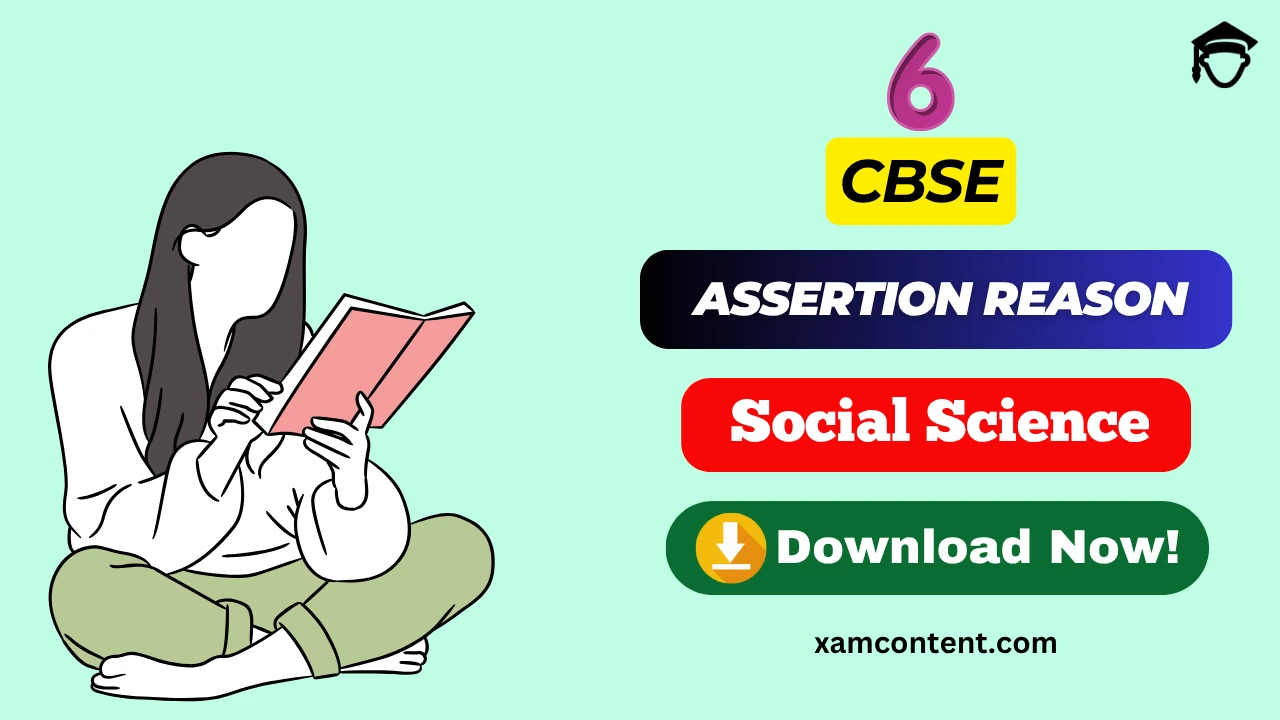Last Updated on November 16, 2025 by XAM CONTENT
Hello students, we are providing assertion reason questions for class 6. Assertion Reason questions are the new question format that is introduced in CBSE board. The resources for assertion reason questions are very less. So, to help students we have created chapterwise assertion reason questions for class 6 Social Science. In this article, you will find assertion reason questions for CBSE Class 6 Social Science Chapter 1 Locating Places on Earth. It is a part of Assertion Reason Questions for CBSE Class 6 Social Science Series.
| Chapter | Locating Places on Earth |
| Type of Questions | Assertion Reason Questions |
| Nature of Questions | Competency Based Questions |
| Board | CBSE |
| Class | 9 |
| Subject | Social Science |
| Useful for | Class 6 Studying Students |
| Answers provided | Yes |
| Difficulty level | Mentioned |
| Important Link | Class 6 Social Science Chapterwise Assertion Reason |
Assertion Reason Questions on Locating Places on Earth
Q1. Assertion (A): The Earth is divided into imaginary lines called latitudes and longitudes.
Reason (R): These lines help us to find the exact location of any place on the Earth’s surface.
(a) Both A and R are true and R is the correct explanation of A.
(b) Both A and R are true but R is not the correct explanation of A.
(c) A is true but R is false.
(d) A is false but R is true.
Show Answer
Ans: (a)
Explanation: Both statements are true, and the reason correctly explains why imaginary lines are used to locate places.
Q2. Assertion (A): The Equator is the longest line of latitude on the Earth.
Reason (R): All other latitudes are shorter than the Equator because they lie closer to the poles.
(a) Both A and R are true and R is the correct explanation of A.
(b) Both A and R are true but R is not the correct explanation of A.
(c) A is true but R is false.
(d) A is false but R is true.
Show Answer
Ans: (a)
Explanation: The Equator divides the Earth into two equal halves and is the largest latitude circle, while other latitudes decrease in size toward the poles.
Q3. Assertion (A): The Prime Meridian passes through Greenwich, near London.
Reason (R): The Prime Meridian divides the Earth into Northern and Southern Hemispheres.
(a) Both A and R are true and R is the correct explanation of A.
(b) Both A and R are true but R is not the correct explanation of A.
(c) A is true but R is false.
(d) A is false but R is true.
Show Answer
Ans: (c)
Explanation: The Prime Meridian divides the Earth into Eastern and Western Hemispheres, not Northern and Southern.
Q4. Assertion (A): Longitudes are also known as meridians.
Reason (R): They run parallel to each other and never meet.
(a) Both A and R are true and R is the correct explanation of A.
(b) Both A and R are true but R is not the correct explanation of A.
(c) A is true but R is false.
(d) A is false but R is true.
Show Answer
Ans: (c)
Explanation: Longitudes are called meridians, but they are not parallel; all longitudes meet at the poles.
Q5. Assertion (A): The distance between two latitudes is always the same.
Reason (R): Latitudes are parallel circles drawn at equal intervals from the Equator to the poles.
(a) Both A and R are true and R is the correct explanation of A.
(b) Both A and R are true but R is not the correct explanation of A.
(c) A is true but R is false.
(d) A is false but R is true.
Show Answer
Ans: (a)
Explanation: The distance between two latitudes is about 111 km everywhere, making them equally spaced.
Q6. Assertion (A): The International Date Line passes through 0° longitude.
Reason (R): It helps to fix the standard time of a place.
(a) Both A and R are true and R is the correct explanation of A.
(b) Both A and R are true but R is not the correct explanation of A.
(c) A is true but R is false.
(d) A is false but R is true.
Show Answer
Ans: (d)
Explanation: The International Date Line lies at 180° longitude, not 0°; 0° longitude is the Prime Meridian.
Q7. Assertion (A): There are 360 longitudes on the globe.
Reason (R): The Earth completes one full rotation of 360° in 24 hours, so each longitude represents a difference of 4 minutes in time.
(a) Both A and R are true and R is the correct explanation of A.
(b) Both A and R are true but R is not the correct explanation of A.
(c) A is true but R is false.
(d) A is false but R is true.
Show Answer
Ans: (a)
Explanation: Both statements are true, and the reason explains why there are 360 longitudes and how they relate to time calculation.
Q8. Assertion (A): The poles have the same local time as the Equator.
Reason (R): Longitudes converge at the poles, making time measurement meaningless there.
(a) Both A and R are true and R is the correct explanation of A.
(b) Both A and R are true but R is not the correct explanation of A.
(c) A is true but R is false.
(d) A is false but R is true.
Show Answer
Ans: (d)
Explanation: The poles do not have a fixed local time since all longitudes meet there, so the assertion is false while the reason is true.
We hope the given assertion reason questions with Answers for Locating Places on Earth Class 6 helps you in your learning.

Also check
- Class 6 Social Science Assertion Reason Questions Chapter 14 – Economic Activities Around Us
- Class 6 Social Science Assertion Reason Questions Chapter 13 – The Value of Work
- Class 6 Social Science Assertion Reason Questions Chapter 12 – Grassroots Democracy Part 3 Local Government in Urban Areas
- Class 6 Social Science Assertion Reason Questions Chapter 11 – Grassroots Democracy Part 2 Local Government in Rural Areas
- Class 6 Social Science Assertion Reason Questions Chapter 10 – Grassroots Democracy Part 1 Governance
- Class 6 Social Science Assertion Reason Questions Chapter 9 – Family and Community
- Class 6 Social Science Assertion Reason Questions Chapter 8 – Unity in Diversity
- Class 6 Social Science Assertion Reason Questions Chapter 7 – India’s Cultural Roots
- Class 6 Social Science Assertion Reason Questions Chapter 6 – The Beginings of Indian Civilisation
- Class 6 Social Science Assertion Reason Questions Chapter 5 – India, that is Bharat
- Class 6 Social Science Assertion Reason Questions Chapter 4 – Timeline and Sources of History
- Class 6 Social Science Assertion Reason Questions Chapter 3 – Landforms and Life
- Class 6 Social Science Assertion Reason Questions Chapter 2 – Ocean and Continents
- Class 6 Social Science Assertion Reason Questions Chapter 1 – Locating Places on Earth
Topics from which assertion reason questions may be asked
- Globe, maps and their components
- Latitude and longitude – coordinates
- Time zones and standard time
Assertion reason questions from the above given topic may be asked.

You may also like

Frequently Asked Questions (FAQs) on Locating Places on Earth Assertion Reason Questions Class 6
Q1: What are Assertion Reason Questions in Class 6 Social Science?
A1: Assertion Reason Questions are a new type of competency-based questions where students are given two statements — an Assertion (A) and a Reason (R). Students must decide whether each statement is true and whether the Reason correctly explains the Assertion.
Q2: How can Assertion Reason Questions help in exam preparation?
A2: These questions help students think critically, understand cause–effect relationships, and go beyond rote learning. They strengthen conceptual clarity in topics like History, Geography, and Civics by testing logical connections between facts.
Q3: How should students approach Assertion Reason Questions?
A3: Students should first read both statements carefully, identify whether each is true or false, and then check if the Reason actually explains the Assertion. Practicing chapter-wise Assertion Reason sets regularly improves accuracy and speed.
Q4: Are Assertion Reason Questions included in CBSE Class 6 syllabus?
A4: While Assertion Reason Questions are not directly mentioned in the NCERT syllabus, they are part of the new competency-based assessment pattern introduced by CBSE to promote conceptual understanding and analytical thinking.
Q5: What types of topics are covered in Class 6 Social Science Assertion Reason Questions?
A5: Topics include key chapters from History (e.g., What, Where, How and When?), Geography (e.g., The Earth in the Solar System), and Civics (e.g., Understanding Diversity) — focusing on reasoning, relationships, and application of knowledge.
Q6: Where can I find Assertion Reason Questions for Class 6 Social Science Chapter-wise?
A6: You can access free, chapter-wise Assertion Reason Questions with detailed explanations at xamcontent.com and physicsgurukul.com. These resources are designed as per the latest CBSE competency-based exam format.
Q7: What are the main components of a map?
A7: A map has three main components: distance, direction, and symbols. Distance helps measure the actual ground distance using a scale, directions help in locating places using cardinal points (N, S, E, W), and symbols represent features like roads, rivers, buildings, etc., in a simplified manner.
Q8: Why do we need latitudes and longitudes?
A8: Latitudes and longitudes form a grid system that allows precise identification of any location on Earth. Latitude measures north–south distance from the Equator, while longitude measures east–west distance from the Prime Meridian. Together, they provide unique coordinates for every place.
Q9: What is the importance of the Prime Meridian?
A9: The Prime Meridian (0° longitude) is the reference line from which all longitudes are measured. It divides Earth into the Eastern and Western Hemispheres and is essential for calculating time differences and standard time zones across the world.
Q10: Why does local time vary from place to place on Earth?
A10: Local time varies because the Earth rotates 15° of longitude every hour. Places located east or west of each other experience sunrise, noon, and sunset at different times. Hence, local time depends on a place’s longitude.
Q11: Why is it difficult to represent the Earth accurately on a flat map?
A11: Earth is spherical, and flattening a curved surface always causes distortion. Just like peeling an orange and trying to lay its skin flat, the spherical shape cannot be perfectly represented on paper without stretching or breaking. Therefore, maps always involve some distortion.



